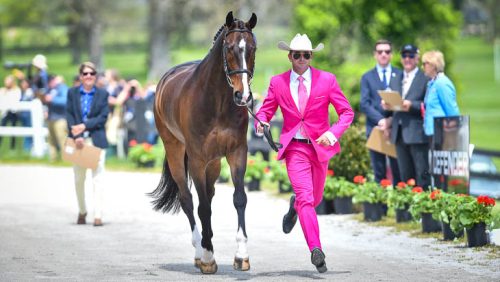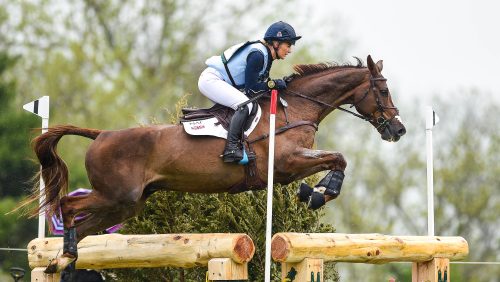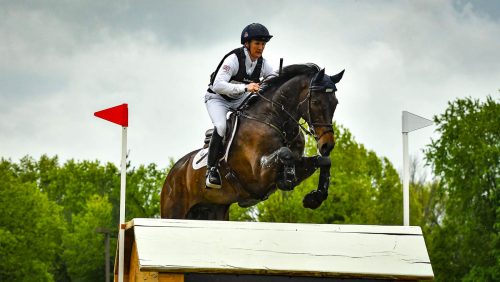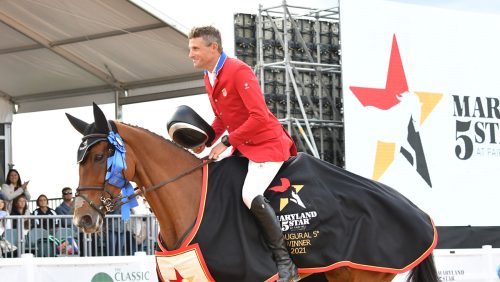For the first time, the Fair Hill CCI*** doesn’t include phases A and C (roads and tracks) or B (steeplechase) on cross-country day. The organizers had offered riders a chance to ride in either a traditional long-format CCI or the new CCI without steeplechase. But only 18 riders entered the full CCI, while 65 riders chose the modified or short-format division.
The question is, will horses complete the 5,875-meter cross-country course (with an optimum time of 10:18) in better shape than they completed the modified CCI at last April’s Rolex Kentucky CCI****? Riders will be concentrating on their warm-up more than they did at Kentucky.
“They’re still going to have to be fit. I don’t think many horses will get inside the time,” said Michael Pollard, who rode S.S. Jett into second place on Thursday.
Fitness is always tested at Fair Hill, and the track, designed again by Derek di Grazia (the 1991 Fair Hill winner), follows basically the same track it has for the last several years. In fact, it’s about 150 meters longer than in 2003. Di Grazia said he expects a few experienced horses and riders to make the optimum time but for time faults to still be influential.
Di Grazia said he hadn’t made any radical design changes as a result of the short format. “At this stage we’re still learning about the format,” admitted di Grazia.
He noted that at Kentucky and Punchestown (Ireland)–two of the three CCIs that have run short format–most horses hit their respiration wall at 7 or 8 minutes. He said that this track will allow them to take a breather at that point as it only includes two galloping fences (fences 23 and 24). “It was just fortunate it turned out that way. I think it should work,” said di Grazia.
The first three fences–the Flower Berm, the Giant’s Table and the Cordwood Pile–are big, galloping fences to help riders and horses find their rhythm. Then di Grazia gives them a gentle introduction to water at fence 4, The Kayak. It’s a log shaped like a kayak, with flowers planted on top, perched on the end of a pond. Horses who curl over the fence could actually land on dry ground before entering the pond.
But 100 meters and a sweeping 180-degree turn later they’ll meet real water at fences 5 and 6AB, the Springhouse. Riders can choose either a straight route over the log drop into the complex, then make a left bend into the water for the bank up and bounce to a beautifully crafted wood and stone house that follows. Or they can jump across the log, from right to left, to get a straight line to the bank and house. They can also avoid the bounce by jumping another house set off to the left and behind the first one, but that route leaves then facing the wrong way.
ADVERTISEMENT
After bouncing over the fast house, riders then turn right for another 180-degree turn and a long gallop (about 500 meters) to fence 7, the Vintage Table, set in the midst of an old driving obstacle.
Then it’s left and 180 degrees again to the new fences 8AB, offset rails called The Chute–a fence designed to make time faults count. Off they go to a gallop over fence 9, the Ditch and Brush, and then comes the newest challenge on this course. Fence 10, the Cherry Tree Corner, comes up after a right turn, but riders could lose or gain time depending on how tight or wide a turn they make to it.
A left turn brings the new fences at 11 and 12, the Osage Option. The combination starts with a log set between two enormous osage orange trees, set at a sharp angle to the two identical but narrower logs that follow as the two options to fence 12. The riders can choose which option they prefer–depending on whether they want to jump the first log from left to right or right to left. The distance to either fence 12 is 21 feet.
“It’s very precise,” allowed di Grazia, noting that riders will have to make a nearly perfect turn to fence 12. “And it will require them to know whether they’ve missed the line” or have maintained their impulsion, said di Grazia.
The long option allows riders to jump fence 11 straight, then take a long gallop around the trees to still jump fence 12 on an angle.
Next is a gallop of nearly half a mile, with two imposing but straightforward galloping fences–fence 13, The Parallel, and fence 14, the Double Brush.
Fences 15 and 16, the Roadside Guard Rails, are a test of boldness and steering. It’s a log with a drop into the old roadbed that bisects the course, up the other side to a narrow (4 feet wide) log. As an easier option, an identical log is set off a turn behind that log.
Just 50 or 60 meters beyond is fence 17, the Farmyard, and fences 18AB, the Corners. Fence 17 is a drop bank preceding the first daunting corner by five or six strides on a right-hand bend. Then it’s a left bend of another five or six strides to the second daunting corner. Riders who don’t want to attempt the second corner can leap a log off the left, but they’ll be jumping away from the direction they want to go.
Di Grazia noted he’s never built a jump out of the roadbed before, and this will require them to be more precise than ever, especially since the next combination is just beyond. “These things are all cumulative. You have to maintain your focus through this whole section,” he said.
ADVERTISEMENT
Up a steep hill and through some trees, next is the familiar black Fair Hill Gate at fence 19. Across the field and behind the Goldman, Sachs Sponsors’ Tent is fence 20AB, the Aqueducts. This two-fence combination was on the course last year–palisades behind brooding ditches, set on a two-stride angle. It tests courage and accuracy at once.
Now horses are galloping off to the far northern end of the course, with the Toothpick Trakehner at fence 21 and then back up a long, steep hill after the imposing three-fence combination called the Storm Serpents at fence 22ABC. Out of the woods and back into the field behind the sponsors’ tent, they make a left turn for the giant-sized Harvest Table at fence 23. Another 300 meters brings The Hammock at fence 24, decorated by woodcarvings of hounds and chickens.
Another combination is next, Wayne’s Walls at fence 25ABC, which has been here for at least two years. A log over a stone wall, downhill one stride to a ditch, then a 90-degree right turn to a narrow log over a stone wall that’s nearly identical to the A element.
There is an option here too–an A element set off the right, which gives horses more time to get ready for the ditch.
Now there’s another 400-meter gallop to fence 26, the Bullfinch, which precedes the second water combination, just 25 or 30 meters beyond, at fence 27ABC, the Chesapeake Water with Decoys.
For this, di Grazia moved the carved wooden loons that were at the first water last year and put them in the middle of the pond. Then a grass-covered slope leads to a brush-covered palisade with a substantial drop, before a left turn to a narrow toothbrush, which di Grazia used last year in the same place for the Pan American Championships.
Two more long gallops and two more galloping fences–fence 28, the Magnum Oxer, and fence 29, the Cornish Bank–bring horses home.














